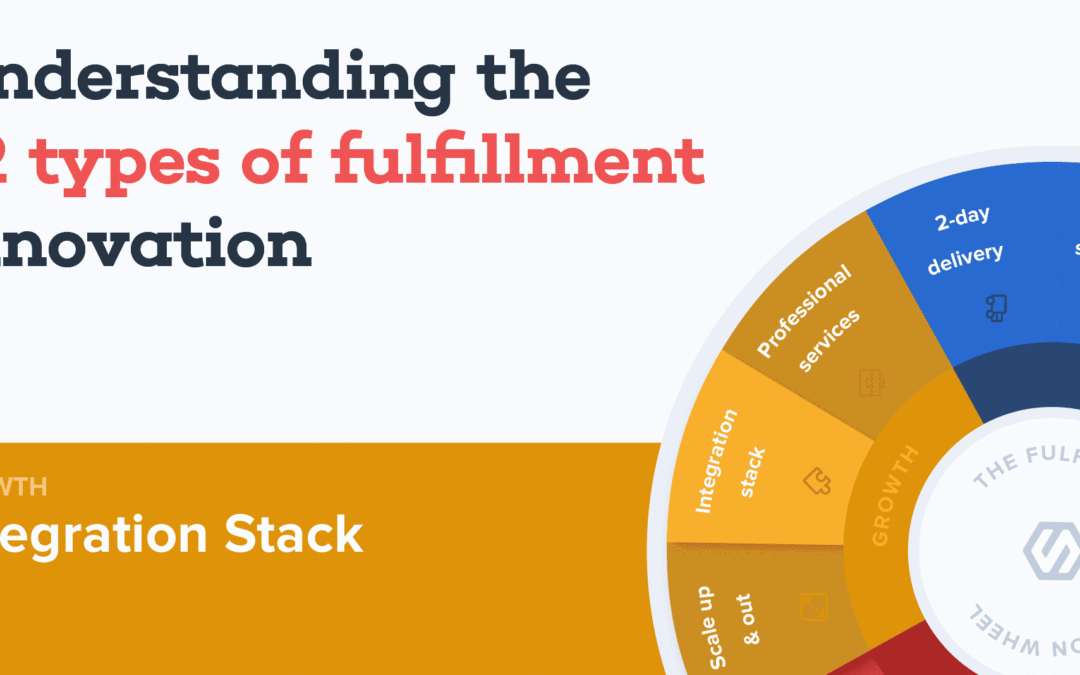
Feb 10, 2021 | Blog, The Fulfillment Innovation Wheel
ShipHero recently launched The Fulfillment Innovation Wheel to help 3PLs understand what capabilities and service offerings they need to implement in order to be successful and to help online retailers and brands choose which 3PL is right for them by allowing them to ‘check the boxes’.
The Fulfillment Innovation Wheel listed a set of twelve (12) capabilities that fulfillment providers and logistics companies should implement to continually delight their customers and push themselves towards greater success and innovation.
The twelve capabilities are:
- 2-Day Delivery
- Same Day Shipping
- At the Box Personalization
- Designed for Returns
- Sustainable Fulfillment
- Resilient Shipping
- Distributed Fulfillment
- Data Now
- Automation
- Scale Up and Out
- Integration Stack
- Professional Services
In this article, we will be diving into Capability #11: Integration Stack.
And be sure to stay tuned for future articles as we deep-dive into each capability.
Capability #11: Integration Stack
These days, all you need to start an online business is a laptop and a dream. With just a few clicks, more and more people are chasing their entrepreneurial passions by leveraging eCommerce platforms like Shopify, Wix and Squarespace, which provide all the software solutions that they need to get their business up and running.
Online businesses today are piecemealed together by a whole assortment of cloud applications, created by different app developers with different methodologies, to accomplish a specific task, e.g, returns, transactional emails, shipping labels, etc. However, without a way to tie them all together, the benefits from the expertise are lost when the entrepreneur is forced to spend enormous effort in navigating from one app to another, figuring out how to transfer information between all of their tools.
So, the eCommerce platforms like Shopify are not inherently powerful in and of themselves; rather, the real power of these platforms lies in their ability to integrate seamlessly with multiple solutions, tying in expertise from a whole plethora of applications that are otherwise customized to do one, specific thing.
Similarly, fulfillment providers need to be able to integrate seamlessly into your business, not to mention offer automation tools to speed up your workflows, leaving you time to focus on what really matters.
The Fulfillment Integration Stack
Retailers have come to expect that their fulfillment provider integrates into the platforms and applications that they are already using, allowing them to transfer data cross-applications and simplify their business processes. However, this is often no easy task.
Only 3PLs and fulfillment providers that are born from agile methodologies and built to scale can offer the wide-ranging integration methods that retailers demand. Without them, they will only slow down your business and as the old adage goes: time is money.
ShipHero’s integration marketplace offers a suite of valuable integrations that make it easy to connect our customers to a long list of shipping carriers and ecommerce platforms. As seen with our recent integrations with Alloy and Returnly, ShipHero is constantly expanding our capabilities and partnering with companies so that our customers have the very best options when it comes to easy, one-click integrations.
Along with our direct integrations, we also have over 20 partners that provide integrations and systems expertise, as well as an open API so that users can code their own integrations and webhooks if it’s not already on our list.
Our customers love the integration that ShipHero provides. We attribute this success on the Fulfillment Innovation Wheel to Capability #11: Integration Stack.
Stay tuned next as we cover Capability #12: Professional Services! At your service, professionally. ShipHero.
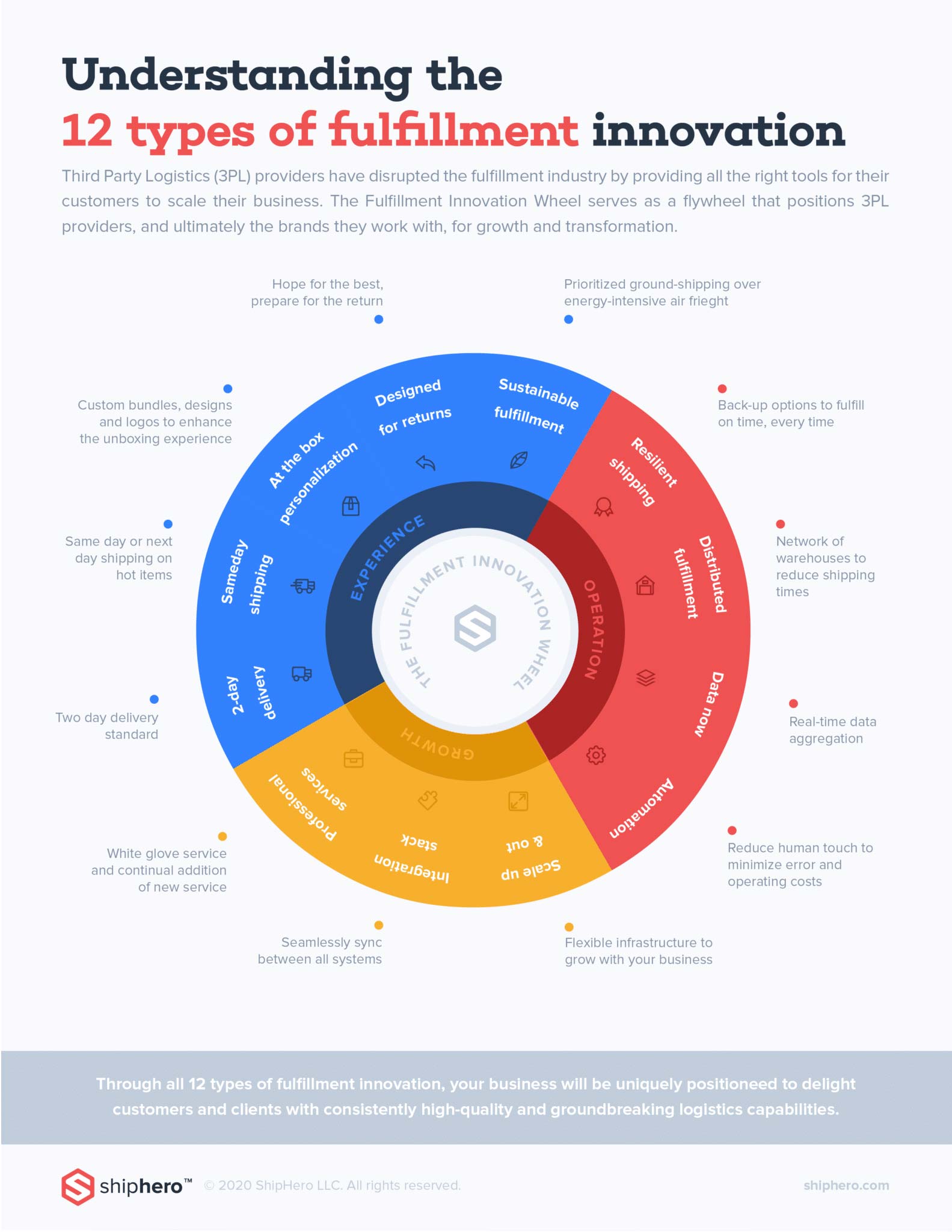
Learn more about ShipHero’s industry-leading warehouse management software.
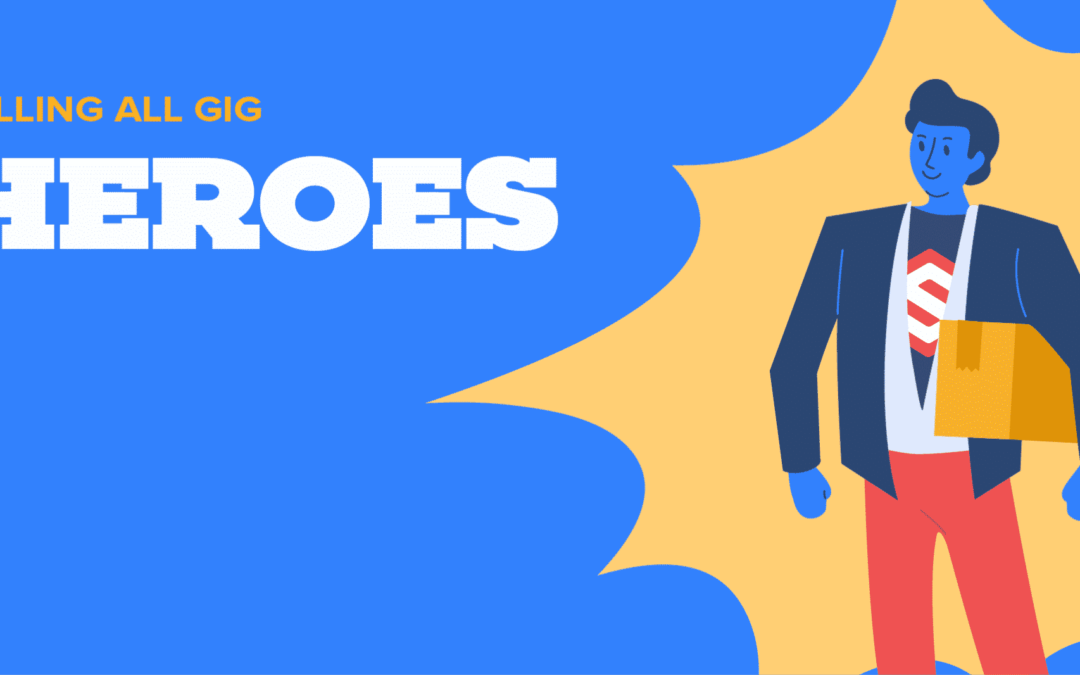
Feb 3, 2021 | Best Practices, Blog, Warehouse Management Software, Warehouse Operations
By all accounts, gig workers are redefining the American Dream. To date, over one third of Americans take advantage of the Gig Economy to enjoy the freedom of setting their own work schedule and chasing projects that resonate with their passions.
There is only growth for gig workers forecasted on the horizon.
While US regulations are finally catching up to the speed at which the Gig Economy continues to grow, more and more major companies are adding freelancers and gig workers to their workforce at varying positions and ranks, up to about two thirds of major companies currently. And 80% of companies are planning to make the switch to independent work in the coming year.
Specifically, several sectors like the warehouse and ecommerce fulfillment industry are ramping up their use of gig workers due to the flexibility and expertise that they provide. Not only that, gig workers in these industries are constantly being offered full-time work if they need more stability. There’s just too much work in ecommerce fulfillment right now.
Gig workers have more control of their work life now more than ever.
Greater acceptance of remote work has proven to be a win-win situation for gig workers. That’s because their work can now transcend the boundaries of where they can physically show up to work, and at the same time, the demand for work that does require in-person attendance is only skyrocketing.
With the advent of staffing platforms like Indeed and AngelList, it’s never been easier for businesses to find and team up with quality and trusted independent workers. This has led to many predictions that virtual organizations and solely-online retailers will continue to rise through the consistent employment of gig workers.
Gig workers are always adept at finding that next big project.
76% of gig workers claim satisfaction in their work life, despite the pressure to continually find projects. But perhaps it is this pressure, rising to the challenge, designing a personal work style and life, that entices gig workers to this style of work in the first place.
Today, 15% of independent workers have side-gigs, and with services like Indeed and ecommerce platforms like Shopify that allow people to market and sell their services and goods like never before, this proportion is sure to grow.
Are you a Gig Hero?
We at ShipHero are seeking gig workers to become Gig Heroes at our warehouses as Pick-and-Packers and fulfillment specialists, because we value the expertise and flexibility that they bring to a work environment. We are currently hiring experienced warehouse team members to join our team to help us pick, pack & ship orders in our 150,000 sqft warehouse in our network in Pennsylvania. You’ll be part of a team that helps ship over $5 billion of e-commerce orders a year, and there’s always options for full-time employment.
Learn more about ShipHero’s industry-leading warehouse management software.
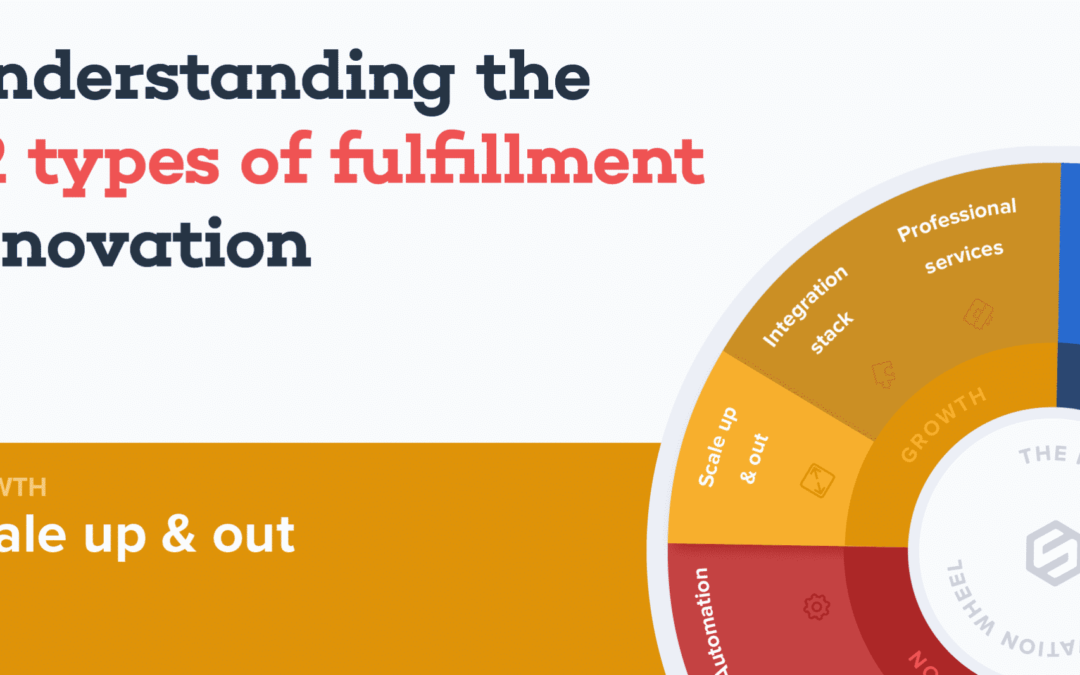
Feb 1, 2021 | Blog, The Fulfillment Innovation Wheel
ShipHero recently launched The Fulfillment Innovation Wheel to help 3PLs understand what capabilities and service offerings they need to implement in order to be successful and to help online retailers and brands choose which 3PL is right for them by allowing them to ‘check the boxes’.
The Fulfillment Innovation Wheel listed a set of twelve (12) capabilities that fulfillment providers and logistics companies should implement to continually delight their customers and push themselves towards greater success and innovation.
The twelve capabilities are:
- 2-Day Delivery
- Same Day Shipping
- At the Box Personalization
- Designed for Returns
- Sustainable Fulfillment
- Resilient Shipping
- Distributed Fulfillment
- Data Now
- Automation
- Scale Up and Out
- Integration Stack
- Professional Services
In this article, we will be diving into the Capability #10: Scale Up and Out.
And be sure to stay tuned for future articles as we deep-dive into each capability.
Capability #10: Scale Up and Out
Your business constantly strives for growth. Whether it’s new customers, new markets, new products, your quest for innovating and providing more value seemingly never ends. Shouldn’t you ask the same of your fulfillment providers?
Without clear-cut criteria and a well-executed strategy for growth, your fulfillment provider could slow your business down. As we saw with this global pandemic, traditional shipping carriers like FedEx, UPS, and even Amazon could not scale quickly enough to meet the soaring demands of the eCommerce boom.
Conversely, FaaS providers and third-party logistics (3PL) companies like ShipHero that were built for scale, equipped with agile development processes and defined expansion strategies, not only experienced tremendous growth and innovation but were able to deliver for their customers when others could not.
We attribute this success on the Fulfillment Innovation Wheel to Capability #10: Scale Up and Out.
The Data-Driven Approach
First and foremost, through real-time data monitoring and executive reporting, your fulfillment provider should get the right data to the decision-makers, so that they can make the best possible decisions when it comes to expansion. Let the data tell you when it’s time to expand, because over-expansion is a kiss of death all on its own.
Make sure you are tracking the data that tells the real story, like ‘Miles Travelled per Order’ or ‘Time to Fulfill’; whatever it may be for your business. Remember, locking in new warehouses to your network is expensive and very difficult to undo, so you need to ensure that there are no simple fixes for your current fulfillment capacity.
At ShipHero, we have clearly defined criteria that informs us when it’s time to expand our operations. We know it’s time to expand when one of the following happens:
- We reach physical storage limits for inventory
- We reach shipping capacity, in terms of the amount of orders that can be shipped in a day
- We recognize regional bottleneck trends, e.g., a distribution center on the East Coast is frequently shipping to the West Coast
If you are a 3PL or FaaS provider, be sure to collect the right data and set clear-cut goals for expansion.
If you are a customer looking to outsource fulfillment, make sure that your fulfillment provider has these in mind, and can grow as quickly you do.
Want to learn more? Some content from this article was borrowed from our previous article: Warehouse Buying 101: A Guide to Scalability, where we dive deeper into the expansion strategy that launched us to become trusted by over 4,000 ecommerce brands and 3PLs every day, in just under a year.
Stay tuned next as we cover Capability #12: Professional Services! At your service. ShipHero.

Learn more about ShipHero’s industry-leading warehouse management software.

Jan 29, 2021 | Blog, The Packet
Front and Center
Environmental Justice League
In a slew of Executive Orders signed during his first week on the job, President Biden aims to tackle climate change through his plan for a Clean Energy Revolution with Environmental Justice. In so doing, Biden has set up several councils and initiatives specifically focused on administering environmental justice and creating green jobs to fulfill his plan.
I’m not saying President Joe Biden is Captain Planet, I’m just saying that I’ve never seen them in the same room at the same time…

What’s the goal?
President Biden’s plan aims to conserve at least 30% of the United State’s lands and waters by 2030. The plan also calls for a pause on new oil and gas leases on public lands and waters, while taking steps to increase offshore wind energy production 100% over the next ten years.
The plan also promises to make major public investments in automobile infrastructure, including 500,000 electric vehicle charging stations, while accelerating R&D on battery technology and battery production. This is sure to increase production and widespread use of EV vehicles, buses and trucks for transportation.
Railway Revolution
Besides him famously commuting to work daily on trains, earning him the nickname “Amtrack Joe” (which would be a sweet rapper name), Biden’s infrastructure plan also promises to usher in the next great railway revolution.
“Biden will make sure that America has the cleanest, safest, and fastest rail system in the world — for both passengers and freight”, reads his Plan. “Biden will work with Amtrak and private freight rail companies to further electrify the rail system, reducing diesel fuel emissions.”
Heavy investments on the railway system will lead to millions of “good, union jobs” for many Americans and breathe new life into America’s middle class. Way to go, Amtrack Joe.
Impact to Logistics
While nobody can be certain what the future will hold, we predict that logistics companies will be forced to move away from transportation systems that carry a heavy carbon footprint (think: air freight) and move towards a more eco-friendly option.
Currently, multi-modal transportation systems that incorporate freight are too complex and downright costly, but Biden’s plan could turn the tides and make freight a viable option once more.
What do you think?? Will freight be a viable option for the future of logistics? Let us know your thoughts by emailing us here.
Back of the Packet
Order Up: 200 Million Piping Cold Vaccines
Besides checking off “climate change” on his presidential to-do list, President Biden also has the COVID-19 pandemic response to deal with. President Biden has ordered 200 million vaccines to be distributed equally between Pfizer/BioNTech and Moderna, in an effort to reduce reliance on vaccines coming from other countries.
Chairman Sander’s Merch
WE CALLED IT! Last Packet you may recall our prediction of the impending global fashion craze launched by the elegant and stunning Bernie Sanders walking the Red.. er.. Blue Carpet. Now Bernie Sanders merch has Sold Out on the Bernie Sanders official website, and all proceeds are going to a good cause.

“…all of the money that’s going to be raised – which I expect will be a couple of million dollars – will be going to programs like ‘Meals on Wheels,’ that feed low-income senior citizens,” Sanders said.
In a trend that just continues to prove the growing importance of political merchandise, the Bernie Sanders meme has taken a viral turn, being featured in everything from album covers to Japanese anime. What is it with Anime artists and Sanders men?
ShipHero News
Design for Returns
We start our The Fulfillment Innovation Wheel series by explaining Capability #4: Designed for Returns.
Plain and simple, customers have come to expect a quick and easy return process. Can’t you just hear them shout “It’s 2021! why can’t this be easier?!” into the ear of your poor customer service rep? That’s why a growing number of businesses, led by Amazon and Walmart eCommerce, have taken the customer-centric approach by offering generous return policies and a frictionless return process.
Find out how your business can offer a frictionless return process and bolster your customer loyalty.
Stay tuned as we break down each of the twelve capabilities. Next we will discuss Capability #10: Scale up and out.
Dropship It Like It’s Hot
In the first of our Shipping Method Explained series, we dive into dropshipping. In this article, we weigh the pros and cons, and discuss when it’s right for your business. Stay tuned as we cover 3PLs and logistics providers next.
Get Featured
We were overjoyed by the fabulous submissions from our wonderful and extremely attractive Packet community. While we engage with these businesses to squeeze every last juicy detail from them to share, we continue our search for more businesses that want to tell their story. If you would like to share with us stories about your ecommerce experiences, whether it’s how you started your business, what opinions you have on the stories we share, or if you just feel like venting… we’re here for you.
Shoot us an email and you could be featured on an upcoming edition of The Packet, or if you’re lucky, you could be invited to join one of our many Podcast episodes or featured on our Blog!
Check out the packets you missed here and Subscribe below so you don’t miss the next one!
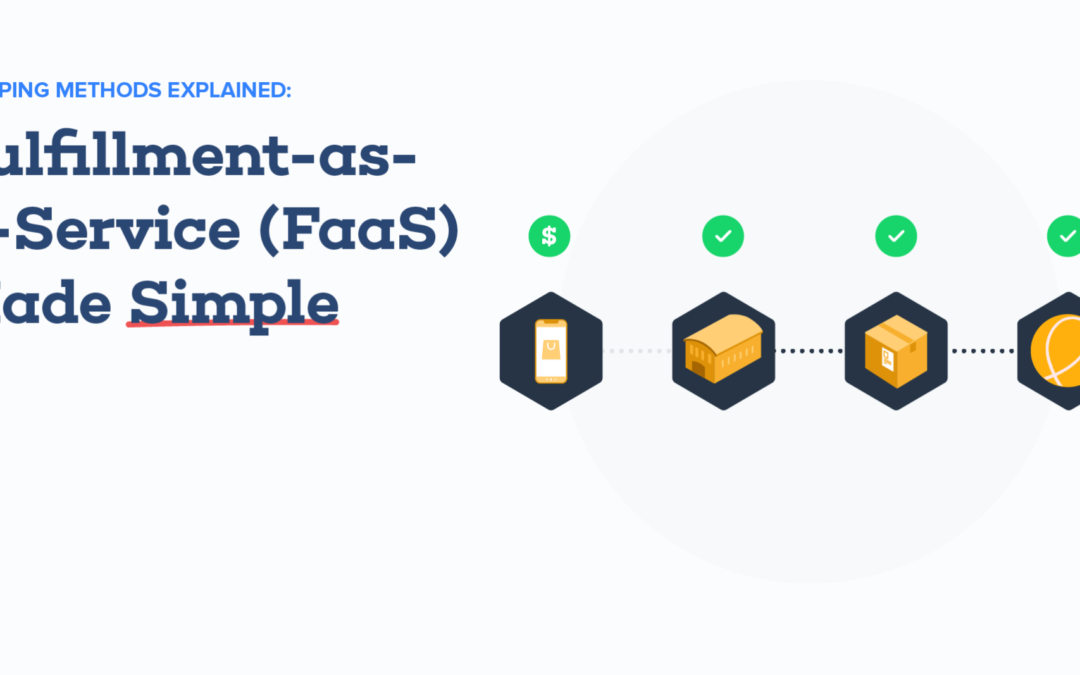
Jan 28, 2021 | Best Practices, Blog, Fulfillment, Warehouse Operations
Welcome to our Shipping Methods Explained blog series. In this series, we will deep dive into fulfillment methods – that is, how businesses fulfill their online orders and get products to their customers.
Sounds simple right? Well, in theory, it is. You could hop on your itty-witty bicycle and hand-deliver your product, mission accomplished. But consider the complexity when your company fulfills hundreds to thousands of orders daily, not to mention the skyrocketing shipping costs that could price you out of the market.
Managing inventory, navigating each carriers’ specific requirements, calculating the lowest cost from thousands of shipping options… it’s a daunting task. That’s why more and more businesses are outsourcing their fulfillment methods.
Are you ready to outsource your fulfillment? Let’s analyze your options to help you decide the best method for your business. In this second article, we’ll discuss Fulfillment-as-a-Service (FaaS). What is FaaS? What are the pros/cons? When is it right for my business? Let’s dive in.
(Check out our first article on Dropshipping here. And be sure to check back for future articles where we’ll cover even more fulfillment methods)
What is FaaS?
Simply put, Fulfillment-as-a-Service (FaaS) is where your company employs a third party company or warehouse to prepare and ship orders for you. This allows you to tap into fulfillment capabilities with no upfront investment of capital, and only pay for the services that you use.
Think about it like a subscription to Netflix. As long as you pay the subscription price, you have access to the content and services. Same with FaaS. As long as you partner with a third party logistics (3PL) provider, you can use them to pick, pack, and ship your product.
Now consider the alternative: in-house fulfillment, where companies must invest heavily in warehouse space, labor, management, and software to keep things running smoothly. With FaaS, this is all included in one subscription price, and you can pick and choose the specific capabilities that you need.
We wrote previously about how to choose which fulfillment method is right for you. Take a look here.
How to Start Shipping With FaaS
With seamless integration between your business systems and their fulfillment cloud-based platforms, getting started with a fulfillment provider has never been easier. All it takes is 3 easy steps to start delivering the goods.
Step 1: Find your Fulfillment Partner
The first step to outsourcing your fulfillment is to find the right FaaS partner for you.
There is an endless list of fulfillment companies vying for your business. So when you are vetting each, ask questions like:
- Does the 3PL provider have the capabilities to fit your business needs?
- Can the 3PL provider integrate with your business systems?
- Does the 3PL provider have a proven track record offering reliable services?
- What are the costs? Do they charge per hour, per unit or packet? Are there transactional fees or recurring costs?
Not all 3PLs operate the same way: some value customization over speed, some strive to be the low cost option at the expense of service, so be sure to select the fulfillment partner that aligns with your specific strategic goals.
Step 2: Integrate
Once you decide on a fulfillment provider, it’s time to integrate.
FaaS providers offer cloud-based software solutions so that your business can utilize their warehouse management capabilities to control the flow of your products. These solutions offer great value to your business because this allows for highly customized options when it comes to fulfillment – custom packing, custom unboxing, custom bundles – you name it.
Also, smart fulfillment companies like ShipHero provide you with the ability to create automated workflows and a frictionless return process through strategic partnerships with companies like Alloy and Returnly.
Step 3: Send Your Inventory
The final step is to send your inventory to your 3PL’s warehouses and get to shipping.
Once the inventory is received, the warehouse will begin to pick, pack and ship your products for you. If you picked a good fulfillment provider that is built for performance and scale, the 3PL will also disperse inventory across their network of warehouses, bringing the products closer to where the orders are coming from.
ShipHero is able to provide 2-day ground shipping for the contiguous US due to intelligent forecasting solutions powered by AI. We bring the products to where your customers are located, instead of a central fulfillment hub. This allows us to lower costs and our carbon footprint through an emphasis on ground transportation.
Fulfillment-as-a-Service Pros and Cons
Is FaaS right for your business? Or would you benefit from dropshipping or another fulfillment method? Let’s look at the pros and cons of fulfillment-as-a-service so you can decide for yourself.
FaaS Advantages
Business with big goals, fluctuating sales, and not enough time all find great value in the FaaS model. Beyond the obvious benefit of saving time and effort by having a third party fulfill your order for you, FaaS provides advantages in terms of skill specialization, agility, and scalability.
Flexible Pricing
As you grow, 3PLs are able to adapt to your needs and adjust costs accordingly. Conversely, when your business goes through a bit of a slow down (hopefully not), the costs can reflect this as well, and you won’t be weighted down with high overhead. FaaS allows you to forego the high costs, risk, and commitment of leasing and operating your own warehouse.
Skill Specialization
When you choose FaaS, you don’t just get a fulfillment provider, you get a business partner. Most 3PLs employ teams of logistics experts and support staff to help you with your shipping needs, and this comes standard with years of experience with fulfillment best practices and software solutions.
Not only do they provide shipping expertise, but also when handling the dirty business of returns. As online shopping continues to grow, so do the number of returned products. 3PLs can help you manage the nightmare of returns and offer a frictionless return experience for your customers.
Agility
If there is one thing that FaaS providers do well, it’s move quickly. Whether it’s shipping times or software development, 3PLs embody the spirit of agility. Many fulfillment providers like ShipHero offer 2-day shipping to anywhere in the US; this would require an immense investment from a business, so more and more retailers are partnering with 3PLs to achieve a level of agility they otherwise wouldn’t achieve.
FaaS Disadvantages
The advantages above explain why more and more retailers are partnering with third party logistics providers and fulfillment specialists. Despite the pros, FaaS is not right for every business.
Need Consistent Orders
If you are a startup or a small business still getting their feet wet, it may be better to handle your orders in-house due to the costs associated with fulfillment-as-a-service. But when customers are knocking down your door and you can’t handle the growing number of orders, 3PLs are standing by to help you as needed.
Lose Full Customization and Control
You’d be surprised with the range of customization that 3PLs can offer, but still there is a limit when compared to the full autonomy that you would have with in-house fulfillment. So if you have very detailed and highly specialized requirements when it comes to fulfillment, handling your fulfillment in-house may be a better option.
So, is FaaS right for your business? If you’re not sure, stay tuned for our next article as we dive into Fulfillment by Amazon (FBA).
Learn more about ShipHero’s industry-leading warehouse management software.






